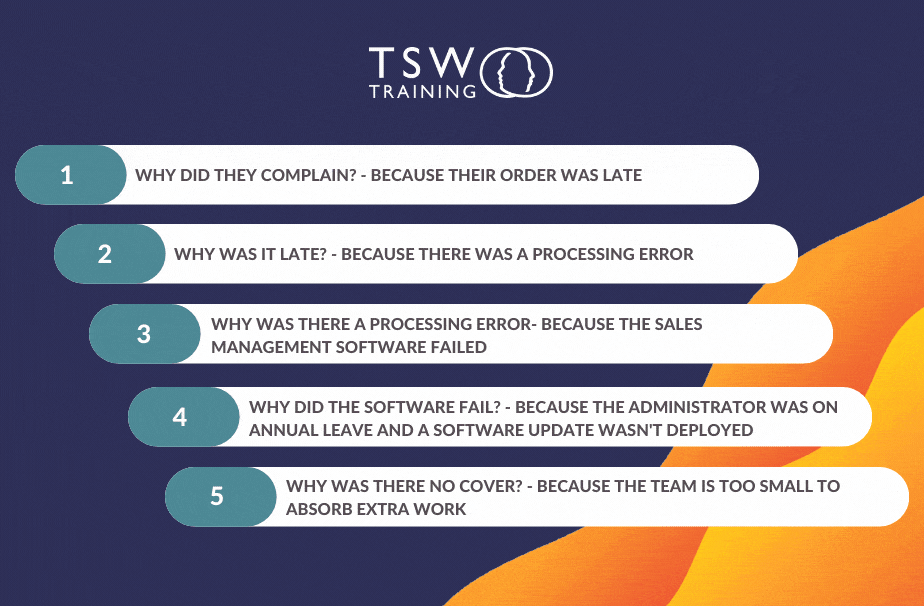In business, it’s inevitable that things will go wrong. Sometimes a quick fix will do, but often it’s better to fully understand the cause of the problem and take steps to ensure it doesn’t happen again.
When trying to find the root cause of a problem, the five whys (AKA 5 whys or 5Y) is a useful technique for team leaders and managers alike, especially if they want to give a concise overview to seniors.
Here we’ll look at what it is, and how it can help your business.
Key points:
- The exercise involves identifying a problem, and asking why it is occurring – drilling down by repeatedly asking ‘why?’ The aim is to get to the root cause of the issue, and apply countermeasures to stop it from happening again.
- It’s an exercise performed in a team, with an appointed facilitator, and a group of people familiar with the problem at hand. The team follows a seven-step process in which root causes are identified, and countermeasures are recommended. Following on from the initial exercise, the measures are implemented and monitored.
- This technique may not be appropriate for more complex problems with multiple root causes. In these cases, a more in-depth approach should be considered.
What is the five whys technique?
The five whys is a technique which can be used for troubleshooting, quality improvement and problem solving across the board. Quite simply, the technique involves asking ‘why?’ five times to identify the root cause of your problem.
Let’s say your company has received a complaint from a customer. Using the five whys technique might produce results like this:
- Why did they complain? – Because their order was late. (First why)
- Why was it late? – Because there was a processing error. (Second why)
- Why was there a processing error ? – Because the sales management software failed. (Third why)
- Why did the software fail? – Because the administrator was on annual leave and a software update wasn’t deployed. (Fourth why)
- Why was there no cover? – Because the team is too small to absorb extra work. (Fifth why, a root cause)
Using this technique will often take you down a route you might not have guessed, which is useful for challenging assumptions. As you drill down, it becomes necessary to ask questions of those on the shop floor, rather than relying on what someone in a boardroom thinks may be the case.
Once the problem is identified, you implement countermeasures. In this example, the countermeasure you could apply to stop the problem recurring is to expand the team, thereby addressing the root cause.
However, it’s best practice to apply countermeasures for all of the whys, not just the fifth why. So you might schedule regular updates to the sales management software, which – while not addressing the root cause – should minimise the problem in future.
The skills our apprentices learn on a Leadership & Management course can prepare them for almost anything.
Listen to our ILM Level 5 delegate Jamie Davies, talk to us about flexing his leadership muscles in the Jordanian desert, during his time as a recruit on SAS: Who Dares Wins.
A very brief history of the five whys
The brainchild of the five whys was inventor Sakichi Toyoda, whose son founded the Toyota Motor Corporation. This technique was employed while the company was evolving its manufacturing methodologies in the 1930s.
“By repeating why five times, the nature of the problem as well as its solution becomes clear.” – Taiichi Ohno, architect of the Toyota Production System
The technique became popular in the 1970s, and Toyota still uses it to solve problems today.
Here’s an example of a problem solved at Toyota using the five whys technique:
Problem: A robot has stopped working
-
- Why has it stopped? – Because a circuit overloaded, which caused a fuse to blow.
- Why did the circuit overload? – Because there was insufficient lubrication on the bearings, meaning they locked up.
- Why was there insufficient lubrication ? – Because the robot’s oil pump isn’t circulating enough oil.
- Why is the pump not circulating sufficient oil? – Because the pump intake is blocked with metal shavings.
- Why is the intake clogged with metal shavings? – Because the pump has no filter.
In this example, the root cause of the problem is that the robot’s oil pump intake has no filter, so the appropriate countermeasure is to install one.
How do I use the five whys?
When it comes to the practical application of the five whys, there’s actually a seven-step process to follow.
# Step 1: Gather a team
When it comes to assembling a team, it’s best to use people who are familiar with the specifics of the problem, but ideally from different departments. This will give you more of a complete view of the process, from a range of relevant perspectives.
Someone should be appointed as a facilitator. This person will chair the exercise and help the team to focus on identifying countermeasures for the problems which arise.
# Step 2: Define the problem
If possible, observe the problem in action. Then discuss it with the team, and write a clear, concise problem statement that everybody agrees on. Keep it to a single sentence, ideally.
Using a whiteboard or sticky notes, write your problem statement, and place it in the middle.
# Step 3: Ask the first ‘why?’
The facilitator should ask the team why the problem is occurring. The responses should be based on facts and real data. Try to chase down accurate accounts, rather than relying on guesswork.
The team should be steered away from conjecture, or giving emotional responses. The process is likely to become confused if you end up chasing hypotheticals.
For each concrete or plausible reason why, write down the answers. Again, do this in a clear and concise fashion, and place them below or beside the problem statement.
# Step 4: Continue to ask ‘why?’
Go through each of the answers generated in step 3 in turn, and ask “why?” four* more times for each. Write each answer down on the board. If you had multiple answers, you will end up with multiple branches, each leading to its own root cause.
Try to keep this step moving quite quickly, and don’t jump to conclusions before completing the exercise.
*Please note that this number isn’t set in stone, as we’re about to see.
# Step 5: Know when to stop
While five whys is the archetype, the number five is just a rule of thumb. You may find that fewer or more questions are required to get to your root cause. When you no longer get any useful responses from asking ‘why?’, this is when you should stop. And ideally you will have identified your root cause.
Each answer in the chain should have a countermeasure ascribed to it.
# Step 6: Address the root cause(s)
You should now have identified at least one root cause. You should discuss any root causes, and agree on appropriate counter-measures to stop the problem occurring again.
# Step 7: Monitor the measures
Once you’ve implemented your counter-measures, it’s important to keep an eye on whether they’re operating effectively. If the problem isn’t eliminated or at least reduced, you may need to revisit them. This may involve repeating the five whys exercise in order to see if you’ve identified the correct root cause.
What are the advantages and disadvantages of using the five whys technique?
Advantages
The five whys technique is beautiful in its simplicity. It’s elegant, and easy to apply.
And when applied properly, it avoids assigning blame. While reasons given may be due to inaction or mistakes made by teams or individuals, the technique seeks to look beyond this, and ask why it is that it occurred. This may be due to organisational issues, and the counter-measures should hopefully highlight processes which need to be improved.
In avoiding pointing fingers, the technique encourages team members to share ideas which will contribute to continuous improvement.
In addition, successful application of the technique should help to motivate your team. It will give them confidence in their collective problem-solving abilities, and empower them to prevent recurring failures in future.
Disadvantages
But is the technique effective? Critics of the technique have argued that it’s too simple. It can be the case that it’s too basic a tool to consistently get to the depth required to truly fix the problem.
The technique is also limited by the investigator or investigators. Results cannot always be replicated, as different people may come up with different answers for the same problem.
It’s generally thought that the process is best suited to problems which aren’t too complex. Some problems may have more than one root cause, and while the five whys process may produce some useful insights, you might be better off using it alongside another approach. For more complicated problems, you could consider using an in-depth technique, such as root cause analysis.
If you need help in developing your team’s problem-solving abilities, feel free to get in touch.








